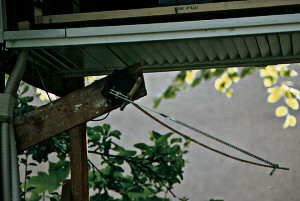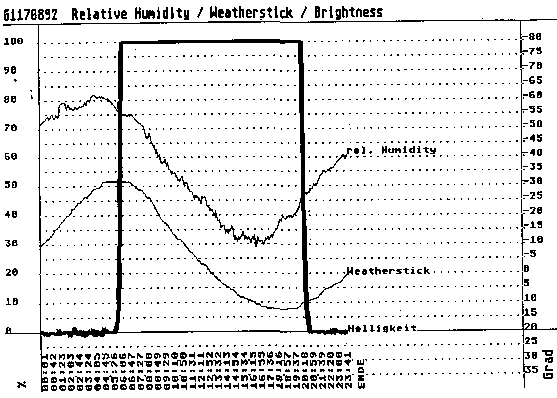|
|
The Online-Magazine
of the DATADIWAN
|
Issue Nr. 1 / March
1998 / ISSN 1435-1560
|
|
|
The Online-Magazine
of the DATADIWAN
|
Issue Nr. 1 / March
1998 / ISSN 1435-1560
|
| Summary:
The Maine Woodman‘s Weatherstick, a dry branch of a northamerican tree species, is sold by the american Company Natural Energy Works of James DeMeo. In their advertisment they state that its bending effect is a competent indicator for life energy (orgone) fields in the air. The bending effect was studied by the research group, Orgone Biophysics, at the Free University Berlin and was compared with meteorological parameters. The experimental set-up is described and the results are discussed. The company years later still sold it under this slogan, though DeMeo was already informed about the arising contrary results in 1992. Keywords:
|
For example, many people have reported to be able to feel life energy in their bodies or in their immediate environments. Hence, human sensibility would be a suitable indicator. Advocates for respected naturopathic methods use the life energy term in order to better describe therapeutic techniques such as acupuncture (with the Chinese term „Qi"), homoeopathy („Dynamis" coined by Samuel Hahnemann), or yoga (using the Indian terms „Prana", „Kundalini", and „Chakra"). The term „Orgone" or „Orgone Energy" was used by the psychotherapist, Wilhelm Reich, for his theory of life energy. Reich derived his own koncept of Sigmund Freud's term "Libido".
These ideas were reason enough for the Berlin study group, Orgone Biophysics,
to theoretically and experimentally research into references of such biologocal
indicators.
The „Maine Woodman’s Weatherstick" as an Indicator of Life
Energy in the Air?
Dr. James DeMeo, a renown advocate of Wilhelm Reich’s Orgone theory,
offers via his company, Natural Energy Works, the so-called "Maine Woodman’s
Weatherstick", an approximately 10 cm long part of a tree trunk. Attached
to this trunk is an approximately 40 cm long branch. The branch has the
special property which enables it to bend at differing intensities for
differing atmospheric conditions. DeMeo asserts in lectures and texts,
that this curvature is due to and dependent on the Life Energy (Orgone)
in the air.
In its advertising materials, found under the title "They really work!",
Dr. DeMeo states:
"During periods of clear, sunny weather, most trees and plants are
reaching upwards strongly, opposing the force of gravity, the sap pushing
strongly upwards, into their limbs. During periods of overcast, rainy weather,
plant limbs droop downwards, and do not reach upwards so strongly. This
bending effect continues in some tree species even when the limb is "dead"
and dry. Some say this is an affect of humidity, but in the living plant,
relative humidity always is at saturation or 100%. Others say it is an
affect of the Earth's electrostatic or orgone (life) energy field, which
is stronger on clear days, and weaker during periods of clouds and rain."
If its bending changes with the amount of life energy in the air, it
would be a suitable indicator for life energy, and it could possibly be
developed into a measuring instrument. The other alternative that the bending
stems from the relative humidity in the air has been mentioned by DeMeo
but has been viewed by him as implausible. He defends this stance by arguing
that in a living plant, the humidity is always in saturation.
A Clarification to the Question through the Experimental Method
Within the framework of the study group, Orgone Biophysics, directed
by Bernhard Harrer at the Free Universitity of Berlin´s Department
of Naturopathy at the University Clinic Benjamin Franklin, a series of
physical experiments were conducted from 1991 to 1994 questioning the postulates
of Wilhelm Reich and other authors.
Two computer-supported measuring stations were used that are generally employed for biophysical dimensions. The ranging values stemming from these specially developed measuring equipments were gathered together through a high-tech data processing. This enabled up to 32 analogue channels with a resolution of 14 bit (16,384 steps) to be digitalized. The values were galvanically separted using fiber-optic cables and transfered with 19 kilobytes to a computer situated 40 meters away. If need be, the values would be digitally filtered and the arithmetic mean for all the values would be calculated and saved on disk. The voltage supply for the measuring stations came from batteries on the premises. The measuring stations, developed by Harrer, would operate for many days without any necessary maintenance, other than that the memory capacity for the immense amount of data had to be regularly changed. One of the measuring stations was set up in a shady garden in Berlin-Steglitz; the other station was placed in Grönenbach in the Allgäu (Southern Germany) in a clean-aired environment in a sunny garden. The stations were housed two meters above the lawn inside a meteorological weather hut (a so-called English Weather Hut).
In order to study the Maine Woodman´s Weatherstick, it was necessary to place it underneath the weather hut so that it would be exposed to all atmospheric conditions except for direct rain.
 |
|
|
As a way of comparison, the relative humidity, the air temperature,
and the degree of light were all determined by electronic instruments.
The humidity was measured by a capacity-type sensor, which responds quickly
and reliably and with near exactness to relative humidity in the range
of 20% to 95%.
The Results of the Series of Measurements
Although the experiments were conducted at two different places over
a period of many weeks, all results showed a typical development, which
is examplarily depicted in Picture 2. The curvature of the Maine Woodman´s
Weatherstick followed with precision the process of the relative humidity.
The stick showed small delayed reactions compared to the quick reactions
of the electronic humidity sensor.
 |
|
|
These results are not surprising, because they meet the expectations that are foreseen from the common reaction of dry wood out in the open. Most types of wood change their volume and also their length grain direction when exposed to temperature and humidity changes. One says, „wood expands". Albeit, the recording and emission of humidity takes a period of time so that a specific delay in time occurs with regards to the real humidity value in the air.
The kind of wood which is used for the Maine Woodman´s Weatherstick has the interesting characteristic that with humidity changes, the top and bottom sides of the branch swell differently, which leads to the obvious curvature effect. Thus, such branches were used by the Indians in today´s Maine, a northeastern state of the USA.
The results of this experiment were given to Dr. DeMeo at a meeting of the Wilhelm Reich Society in 1992 in Berlin. Even though the question "humidity or Orgone" was answered by these results, DeMeo continued to sell this Maine Woodman´s Weatherstick using the original slogan that it would be a suitable indicator for Orgone Energy.
| Berlin, February 7, 1998 |
Bernhard Harrer
|
|
|